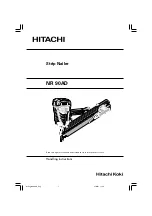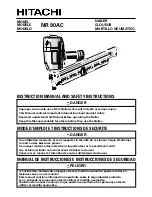
8
CAUTION
Do not store tools in a cold weather environment to
prevent frost or ice formation on the tools’ operating
valves and mechanisms that could cause tool failure.
NOTE:
Some commercial air line drying liquids are
harmful to “O” rings and seals. Do not use these low
temperature air dryers without checking compatibility.
AIR SUPPLY PRESSURE AND VOLUME
Air volume is as important as air pressure. The air
volume supplied to the tool may be inadequate because
of undersize fittings and hoses, or from the effects of dirt
and water in the system. Restricted air flow will prevent
the tool from receiving an adequate volume of air, even
though the pressure reading is high. The results will
be a slow operation or reduced driving power. Before
evaluating tool problems for these symptoms, trace the
air supply from the tool to the supply source for restrictive
connectors, low points containing water and anything
else that would prevent full volume flow of air to the tool.
REQUIRED DAILY CHECKLIST
See figure 8 -10.
1. Disconnect the air supply from the tool and remove
all fasteners.
2. Check all screws, nuts, bolts, and pins on the tool. If
any of these are loose, they must be tightened with
the appropriate size wrench.
3. Press the workpiece contact against a workpiece to
ensure that it moves smoothly.
4. With the workpiece contact depressed, pull the trigger.
The trigger should move smoothly, without binding.
5. While the tool is not loaded, connect the appropriate
air supply at 4.8 bar (70 psi) to the tool.
6. Rotate the selectable trigger knob on the trigger to
single sequential actuation operation, position A
(See
figure 8)
. No air should leak from the tool.
●
Without pulling the trigger, press the workpiece
contact against a workpiece several times. The
tool must not operate.
●
With the workpiece contact not engaged on the
workpiece, point the tool down and away and pull
the trigger several times. Hold the trigger in this
position for a minimum of 5 seconds. The tool
must not operate.
●
Press the workpiece contact firmly against the
workpiece. The tool must operate.
●
With the workpiece contact still depressed,
release the trigger. The driver must return to its
up position.
7. Rotate the selectable trigger knob on the trigger to
contact actuation operation, position B
(See figure 8)
.
●
With the workpiece contact not engaged on the
workpiece, point the tool down and away. Pull the
trigger. The tool must not operate.
●
Keeping the trigger fully depressed, push the
workpiece contact against a workpiece. The tool
must operate.
8. If the tool successfully meets all the requirements in
this checklist, it is ready for use. Set the trigger on
the tool to operate in the manner that best fits your
application. Load the proper fasteners for the desired
application.
Note:
Do not use this tool in the contact actuation
mode unless you have had training in the use of
this mode of operation. Untrained or inexperienced
operators should not use the contact actuation mode.
9. Set the depth of drive according to the “drive depth
adjustment” section in this manual. Repeat this
checklist before using the tool each day, or if the tool
is dropped or damaged in any way.
ACCESSORIES
To order parts and maintenance kits, call
Australia - 1300 361505
New Zealand - 0800 279624
WARNING
Current attachments and accessories available for
use with this tool are listed above. Do not use any
attachments or accessories not recommended by the
manufacturer of this tool. The use of attachments or
accessories not recommended can result in serious
personal injury.
Summary of Contents for AFNDA2565
Page 1: ...AFNDA2565 ANGLED FINISH NAILER ORIGINAL INSTRUCTIONS ...
Page 2: ...2 1 4 10 9 8 7 5 6 3 4 9 11 12 Fig 1 Fig 2 Fig 3 ...
Page 3: ...1 2 15 16 17 1 13 7 14 5 2 8 4 Fig 4 Fig 6 Fig 5 Fig 7 Fig 8 Fig 9 ...
Page 4: ...19 6 10 21 7 20 18 1 2 Fig 10 Fig 12 Fig 11 ...
Page 15: ......
Page 16: ......


































